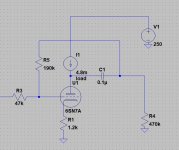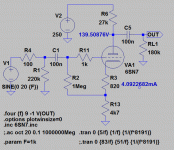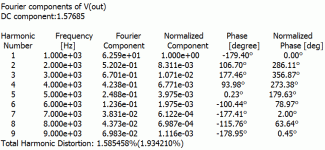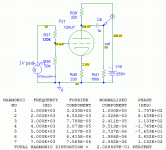Simulation shows that 120V PP could come close to clipping as the cathode voltage comes up and the anode voltage comes down, with distortion pretty ordinary. How about an "anode follower" with feedback to the grid like an op amp inverting amplifier? You could combine this with CCS loading for even better performance. The sim shows 0.36% distortion (nearly all 2nd harmonic) with a gain of 3 and 120V PP.
Attachments
If you only need a gain of 3, are you opposed to using other tubes? A triode connected 6V6 with an unbypassed cathode should be around there. Might need to CCS or choke load it, though.
A triode connected 6P43P-E will be close to the same, but will be able to do it with less supply voltage (~200 or so) to give you more headroom for a traditional anode resistor for similar swing.
A triode connected 6P43P-E will be close to the same, but will be able to do it with less supply voltage (~200 or so) to give you more headroom for a traditional anode resistor for similar swing.
A triode connected 6V6 with an unbypassed cathode should be around there.
So will a 6P45S
What load impedance??! Critical bit of amplifier design.
> more h3 than h2 not very good.
Not going to happen with a simple single triode. The curve is one-way, except at extremes you do not want to reach.
The way to hit "gain of 3" is to use a low-Mu tube, un-bypass the cathode resistor, and then pad-down the input to make your gain. (Or NFB.) The values below (for a similar tube) give gain of 3.2, adjust to taste. THD @ 3.2V peak out is 0.2%, "all" 2nd (as expected from triode curvature).
> more h3 than h2 not very good.
Not going to happen with a simple single triode. The curve is one-way, except at extremes you do not want to reach.
The way to hit "gain of 3" is to use a low-Mu tube, un-bypass the cathode resistor, and then pad-down the input to make your gain. (Or NFB.) The values below (for a similar tube) give gain of 3.2, adjust to taste. THD @ 3.2V peak out is 0.2%, "all" 2nd (as expected from triode curvature).
Attachments
- Status
- This old topic is closed. If you want to reopen this topic, contact a moderator using the "Report Post" button.
- Home
- Amplifiers
- Tubes / Valves
- Best way to set very low tube gain



